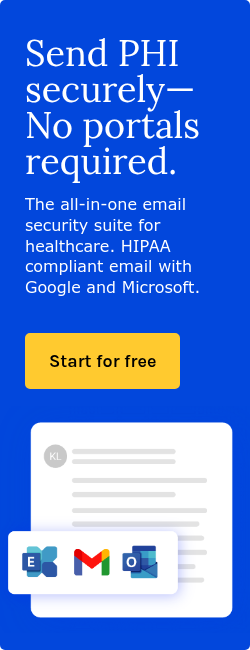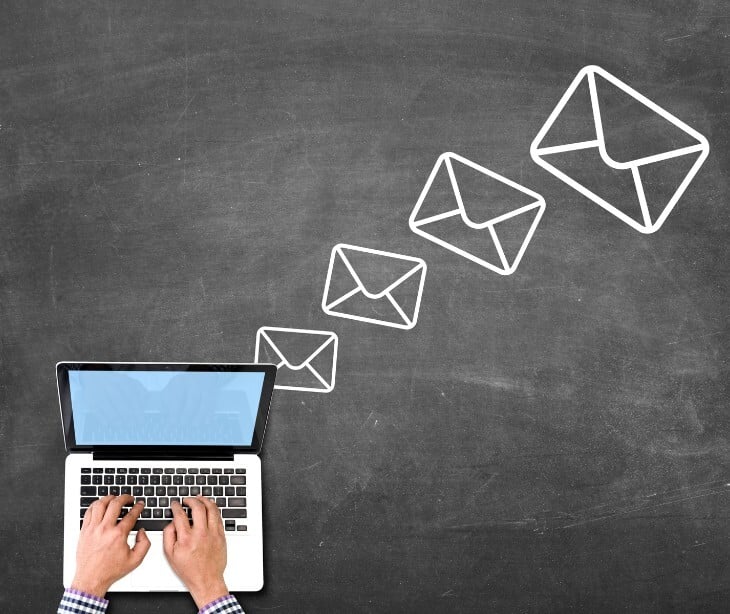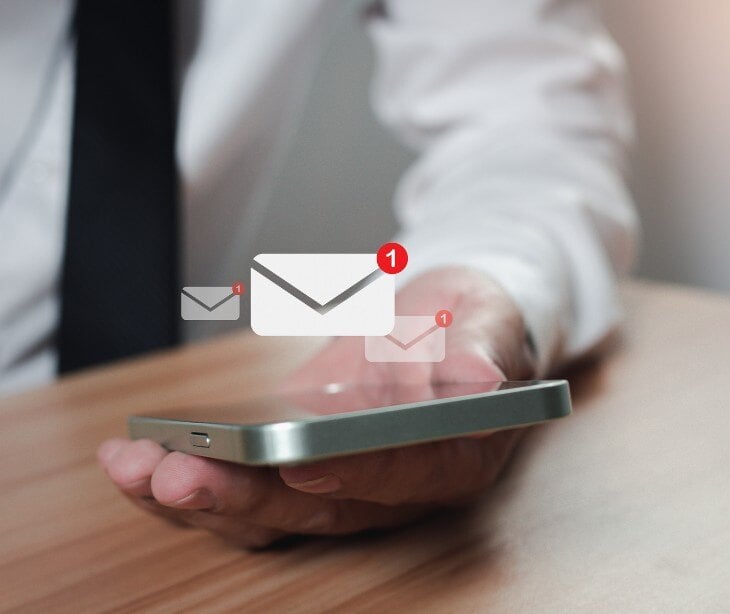6 min read
How smart email tagging can enhance HIPAA compliance workflows
Lusanda Molefe April 16, 2025

The healthcare industry operates amidst a constant flood of digital communication. In fact, according to a study from Cambridge University Press, “email is now a primary method of correspondence between healthcare professionals” for everything from coordinating patient care to managing administrative functions.
For healthcare professionals, navigating this high-volume environment often feels like searching for a specific patient's email in an overwhelming inbox haystack. While email is necessary, the task of managing it in a way that adheres to the stringent regulations of HIPAA presents a growing burden. Relying on manual processes for HIPAA email compliance introduces significant risks and inefficiencies, with 95% of healthcare breaches resulting from human error, according to a 2024 Cofense report.
Staff struggle with the inconsistent identification of emails containing protected health information (PHI) that require special handling, leading to the potential for sensitive data to be overlooked. PHI includes any information that can identify an individual and relates to their health condition, treatment, or payment for healthcare services, such as names, dates, locations, and medical record numbers. Research about patient confidentiality states that this complexity, combined with the varied forms in which PHI can appear in emails, contributes to the challenges faced by staff in accurately identifying and managing these sensitive communications. The preparation for audits becomes a time-consuming and resource-intensive endeavor, often involving manually sifting through countless emails. Furthermore, the inconsistent application of record retention policies based on individual user memory can lead to both over-retention and premature deletion of important communications. Smart email tagging offers an automated solution to bring order to this chaos, providing a more organized, trackable, and manageable approach to email that aligns directly with HIPAA compliance requirements.
Why traditional email management fails HIPAA workflows
While email remains a cornerstone of healthcare communication, relying on traditional, manual methods of organization and management often falls short of the stringent requirements mandated by HIPAA. This manual approach introduces several pain points that can lead to inefficiencies, increased risks, and potential compliance failures.
- PHI identification: Staff struggle with the inconsistent identification of emails containing protected health information (PHI) that require special handling due to the varied nature and context-dependent appearance of PHI within high volumes of daily emails, increasing the risk of human error. This inconsistency can easily lead to sensitive data being overlooked and handled without the necessary security precautions, such as encryption or restricted access.
- Preparing for audits: When an audit request arises, organizations relying on manual methods face the daunting task of sifting through potentially thousands of emails across numerous employee accounts. This time-consuming and resource-intensive process makes it difficult to quickly and accurately locate all relevant communications within the required timeframe.
- Retention: Manually applying record retention schedules is prone to inconsistencies. Relying on individual users to remember retention policies and manually manage folders often results in emails being kept for too long or, conversely, being deleted prematurely, both of which can lead to compliance issues.
- Collaboration and continuity gaps: When patient-related communications aren't properly tagged or linked, tracking the full thread of information across different individuals and over time becomes challenging, potentially hindering seamless patient care and effective team collaboration.
- Security blind spots: Without automated oversight, it's difficult to gain visibility into potentially risky communication patterns, such as the transmission of PHI to personal email addresses or other unauthorized recipients.
Given that the average office worker deals with a staggering amount of email daily, according to stats from career experts, the sheer volume amplifies these challenges. The reliance on manual email management for HIPAA and the human error leading to a breach of sensitive patient data, coupled with the enormous burden of audit preparation, makes it a fundamentally flawed approach in today's regulatory environment.
The real dangers of relying on traditional email management are demonstrated by numerous incidents. For example, in December 2024, Seven Counties Services, Inc. experienced a data security incident stemming from a phishing email. This human error led to the compromise of multiple staff email accounts over nearly a month, potentially exposing a wide range of PHI of their clients. This included not only names but also sensitive details such as dates of birth, Social Security numbers, addresses, diagnoses, medical history, and even photos. This incident shows how a single instance of human error, such as responding to a deceptive email, can have significant consequences for the privacy and security of a large number of individuals.
The automation and organization of smart email tagging
Smart email tagging represents a significant leap forward from traditional, manual email management by introducing automation and intelligent organization to the inbox. Smart tagging is the automated application of metadata labels, or "tags," to emails based on predefined criteria or intelligent analysis. Unlike manually created folders or user-applied labels, which rely on consistent human action, smart tagging systems work autonomously to categorize and enrich emails with relevant information.
These systems employ various mechanisms to achieve this automation:
- Rule-based systems: These are often the foundational layer, where tags are applied based on specific rules configured within the system. These rules can look for patterns such as the sender's or recipient's email address, keywords present in the subject line or body of the email (for example, "Medical Record Number," "Prescription Refill," or even "PHI"), the type of attachments included, or the date the email was received. A real-world example of this is the upcoming Paubox [Tags] feature, which allows administrators to set up rules to automatically append tags to the subject line of incoming emails based on the sender's email address and the strictness of their SPF record. This allows users to quickly identify legitimate and safe emails, such as 'Safe to pay' for a renewal invoice from a known vendor. When an email meets the criteria of a defined rule, the corresponding tag is automatically applied.
- Content analysis & AI/ML: More advanced smart tagging solutions leverage the power of Artificial Intelligence (AI) and Machine Learning (ML), particularly Natural Language Processing (NLP). These systems can go beyond simple keyword recognition to understand the context and meaning of the email content. They can identify sentiment, detect patterns indicative of PHI even without exact keywords (for instance, recognizing a patient's diagnosis or treatment plan discussed in the email body), and learn over time to improve their tagging accuracy. Research from Oregon State University has explored using 'implicit feedback', analyzing user interactions with emails, such as the time spent reading or actions taken, to further refine the accuracy of these AI systems. The idea is that if a user spends a significant amount of time with an email and doesn't change the automatically applied tags, it suggests the tags are correct, providing valuable positive feedback to the learning algorithm.
Smart email tagging systems are designed to integrate with existing email platforms like Microsoft 365 and Google Workspace, often working as an overlay or a connected application. More sophisticated implementations might also integrate with other systems critical for HIPAA compliance, such as data loss prevention (DLP) tools, email archiving solutions for long-term retention, or even, in some advanced setups, with electronic health record (EHR) systems to link email communications to patient records.
These are labels that the smart email tagging system automatically puts on your emails to help organize them and ensure they are handled correctly for HIPAA compliance. Think of them like digital sticky notes that get added to your emails without you having to do it yourself:
- PHI detected: This tag means the system has identified that the email likely contains PHI (like a patient's medical condition or treatment details). This tag could then trigger extra security measures, like making sure the email is encrypted.
- Patient inquiry [Specific patient name or ID]: This tag shows that the email is a question or request from a specific patient. This can help organize patient communications and ensure timely responses.
- Requires encryption: This tag indicates that the email needs to be encrypted to protect the sensitive information inside, according to HIPAA rules. The system might automatically encrypt it or remind the sender to do so.
- Legal hold: If there's a legal reason to keep an email (like a lawsuit), this tag ensures it's preserved and not accidentally deleted, which is important for legal and compliance reasons.
- Audit request [Date range]: When there's a need to review emails for a specific period (like for a HIPAA audit), this tag can help quickly find all emails that fall within that date range.
- To be archived [Retention policy name]: HIPAA has rules about how long patient records need to be kept. This tag helps ensure emails are archived (stored securely long-term) according to the correct retention policy.
- Billing communication: This tag helps identify emails related to patient billing. This can be useful for organizing financial records and ensuring billing-related PHI is handled appropriately.
- Urgent clinical alert: This tag highlights emails that contain important and time-sensitive clinical information that needs immediate attention from healthcare staff.
The idea is that by automatically adding these kinds of tags, the smart system helps healthcare organizations better manage their email communication in a way that is more organized, secure, and compliant with HIPAA regulations, without relying on staff to manually categorize every email.
FAQs
What is metadata in the context of email tagging?
Metadata refers to the additional information that can be automatically added to an email, like tags. These tags provide context and help categorize emails beyond just the subject line and content.
What is Natural Language Processing (NLP)?
NLP is a branch of Artificial Intelligence that enables computers to understand and process human language. In smart email tagging, NLP can help the system understand the meaning and context of emails, even if they don't contain specific keywords.
What is data loss prevention (DLP)?
DLP refers to systems that are designed to prevent sensitive information, like PHI, from leaving an organization's control, often by monitoring and controlling data in use, in motion, and at rest. Smart email tagging systems can integrate with DLP to enhance these controls.
How is smart email tagging different from just using folders in my email?
Folders rely on manual organization by the user, which can be inconsistent and prone to error. Smart email tagging automates the process of categorization based on rules or AI analysis, ensuring more consistent and accurate organization.
Does smart email tagging read the content of my emails?
Yes, in order to accurately apply tags, especially with AI-powered systems, the smart email tagging solution needs to analyze the content of emails. However, reputable systems are designed with security and privacy in mind, particularly in the context of HIPAA.
Subscribe to Paubox Weekly
Every Friday we'll bring you the most important news from Paubox. Our aim is to make you smarter, faster.




